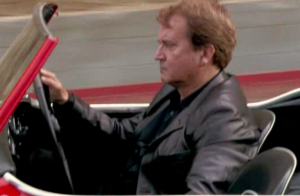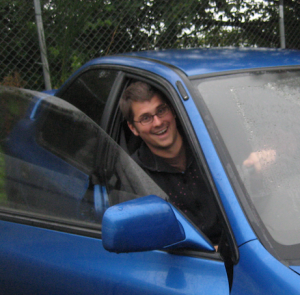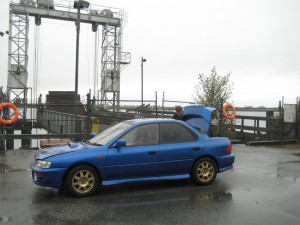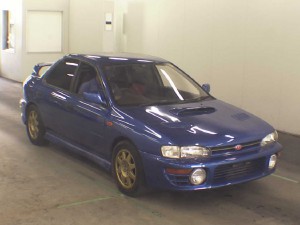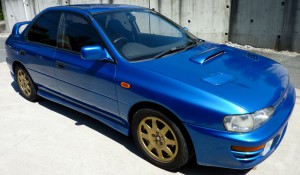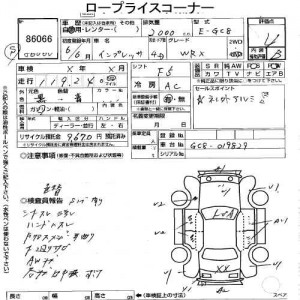Right Hand Drives on The Big Screen, Volume 2
I've found a few more 'mixed drive' shots of right-hand drive cars, as an extension of Right Hand Drives on the Big Screen from a while ago. The rules are that the car must be a right-hand drive in left-hand drive traffic.
Darkwing Duck (that people of a certain age will be all misty-eyed over) has a motorcycle that magically changes from LHD to RHD. It's either a mistake, or just looked better that way for these shots. It's 'wrong' in all but one of the shots it's in.
And finally, Arrested Development in the episode 'For British Eyes Only'. Canadian actor Dave Thomas pulls up beside Michael (who is driving the stair truck) and starts making hand signals at him after Michael's time in 'Little Britain' (which drives on the left side of the road, despite the fact it's in America).
I believe he's dring a Triumph, but I could be corrected on that. It's something British, at any rate... and probably lives in LA somewhere. So, hypothetically it's 25 years old or older.
Conversation with an MLA about Grey Market Vehicles
I've replied to the message from an MLA that I got a while ago that was in response to my open letter to the government of Manitoba. I thought I would share it with everyone, as I think it is quite good.
It took me a while to get back to them. I feel that the MLA was trying to shrug me off, and it took me a while to decide whether or not Manitoba Public Insurance (MPI) is the place to bring this up or not. I've decided it's not. Laws are changed by lawmakers. MPI carries out the law, the legislature makes the laws... so I've decided to go to the source. As I say in the letter, I believe that MPI should be a voice in the conversation... but MPI alone does not have the power to make the changes I'd like to see.
My prediction: wait a month or two for a response. I can't really judge since I took about that long to respond to their email.
Without further adieu:
Mr McNeil,
First of all, thank you for your thoughtful reply. I appreciate the time you took to respond to my email. I apologize for the time it has taken me to get back to you.
Though MPI administers the law, the legislature makes the laws. I agree that MPI is a stakeholder and should be an active member in the conversation about changes to any vehicle safety standards, but the changes must take place at a higher level. I have had a meeting with some MPI staff, and they have been very helpful answering my questions and meeting with me, but I feel that these changes are beyond their jurisdiction.
But, the problem as I see it is that Manitoba is falling behind the times in terms of vehicle safety. The world is getting smaller, and it is becoming easier for regular folk to import the cars of their dreams from other countries. I don't see this as a passing fad, and I believe that it should be looked at and handled sooner rather than later.
The most important part of the argument is that it is absurd and archaic that ECE coded (e-coded) lighting is not accepted in Manitoba. This is a world standard that has been accepted in the Motor Vehicle Safety Act (http://www.tc.gc.ca/eng/acts-regulations/regulations-crc-c1038-sch-iv-108.1.htm), and a precedent has been set by allowing vehicles such as Mercedes Benz into the country, as they have no DOT markings, but only ECE markings. Clearly proper e-codes for left-hand drive countries must be marked on the headlights, but all ECE markings should be accepted for non-headlight lighting.
Accepting ECE markings will not make the vehicles less safe, and bring Manitoba up to the world standard for safety.
ICBC, the public insurer for British Columbia has already implemented some of these changes, including accepting JIS (Japanese standards) to the fold. Accepting national standards from other 1st world countries makes sense in this which is getting smaller. I understand that not every vehicle should be permitted on Manitoban roads (the autorickshaw from India comes to mind), but accepting other-national standards for imported cars (15 years or older) makes sense for this ever-shrinking world.
I've attached my full technical document again for your perusal, as I believe it outlines my argument well.
Thank you again for your time.
Robert Guderian
My Import Story, A Summary
If you've been reading through my import story, you might be overwhelmed. Initially, its pretty frightening to say, "I'm going to buy a car that's on a different continent." And it probably should be.
In the end it's simple... well, simple enough. Here's the quick breakdown.
- Know what you want to buy, and how much you're willing to pay.
- Find an importer you like.
- Buy a car
- Pay for the car
- Ship the car
- Wait
- Wait
- Wait
- Clear the car through customs (probably with help)
- Drive the car home (don't forget temp insurance!)
- OOP/Safety your car
- Register your car
The end! The devil is really in the details. But for the best part, you deal with the problems as they come along.
Would I do it again? Heck yes. I still want a SWB Pajero TD and now I want a Suzuki Alto Works (badass kei car!), and I'll very likely get another minitruck one day. They're too useful to not have!
Importing is like getting a tattoo. It's really scary the first time, but you want to do it again as soon as possible.
My Import Story, Part 6
Apparently this turned into a huge series. This is the last chapter.
Getting your car home!
So, you've bought a car, shipped it, picked it up, and now you need to get it home. A few ways to do this. There are car carriers, but they tend to hate JDMs. Too bad. The fact they ship with no gas and usually have dead batteries when they get here doesn't help.
But, what most people do: have a great excuse for a road trip.
I only have one piece of advice for this part of the import process: In bold, and all caps. KEEP YOUR EYES ON THE OIL TEMPERATURE. I've heard of a few cars that have died 100km from their final destination. Due diligence would be to check your oil every time you fill up the tank, a good idea but a bit of overkill.
Getting your car insured
BC and Alberta require an OOP - Out of Province inspection. Other province might, but I don't know about that. Manitoba I do know about. Just a regular safety inspection will do. Your problem will be getting someone to look at your car, but that's a whole story on it's own. Compliance is also another story. Once day....
Paperwork you will need once you have your inspection completed:
- Something that says how much you paid for the car, so you can be taxed on it (again)
- Transfer of ownership documents with the address of the previous owner
- Deregistration from Japan
- Translated deregistration from Japan
- Your Form 1 from Transport Canada (saying it's been imported properly)
- Your completed safety
And that's really it. You're plated and ready to go! Congratulations.
Now this all sounds like quite a lot... but it's not. And it's worth it.
Next time: A summary, followed by a quiz.
My Import Story, Part 5
So. You've bought and paid for a car, cleared it though customs, now you want to pick it up. If you did all the work yourself, the car will be at the docks in a imported car common area. If you went through a bonded shipping agency, the car will be at their warehouse. Mine was the latter.
Before you even leave for the docks, you'll need temporary car insurance. Pretty simple to get. I forget which documents you need to get one. Probably the VIN/Chassis code for the car, and some proof that you own the car. In Manitoba you can get temporary insurance to only come into effect on a certain date.... so make it the day you get your car. Temporary insurance isn't cheap, so you probably don't want to pay for something you're not using.
This is what I looked like when I picked up my car:
That's a bit of an embarrassing photo. I think that everyone that picks up their car at the dock looks like that though. Below you'll see a picture of me filling the gas and doing the checks. The background you'll see what a prairie boy calls the ocean. That's awesome.
So, your car has been in shipping for about a month now. And you've never seen it in real life before. And if you're like me, you're about to drive it 2000km. You'd be an idiot to not check it out before you start driving it.
First off, these cars ship with the absolute minimum amount of fuel. Probably want to bring a jerry can of premium with you. Why premium? The gas is a bit old, and you don't know what they filled it with. Be nice to your car, it's the new kid in town.
Also, your battery might be dead, or lost its charged. Bring booster cables, or something to boost your car with.
Then, just some regular check.... here's what I did for a checklist.
- Fill up the tank.
- Check the oil
- Make sure there is coolant in the reservoir
- Make sure they're coolant in the radiator (remove coolant cap, make sure it's full)
- Try to start it... probably boost it.
- Let the car run... any weird sounds?
- Check brake fluid, move the car and make sure it stops (usually not an issue, but...)
- Check power steering fluid
- Make sure all lights work (especially brake lights). Again, not usually an issue, but you don't know.
- Check windshield wipers and washing fluid.
Am I pedantic? Yes. Have I seen this car before or know anything about it? No. They're all simple checks that can save you from a world of hurt later on into life. Just do it. Worst case scenario you can brag about how great your car was right off the boat.
Summary:
Bring temporary insurance, gas and booster cables. Bring oil, coolant, brake and washer fluid if you're feeling _really_ unlucky.
And there's still more. If you're most Canadians, you don't live in or around Vancouver. So, the ride home and insurance is coming up!
My Import Story, Part 4
So, you've bought a new car... you've paid for your new car, now for shipping.
Brave Auto (I sound like a broken record) does container sharing within the company. Four customers buy cars, and they get shipped out together. This is really one of the cheapest and safest routes to go. Again, Brave Auto uses 'CIF' purchasing, so the shipping is included.
With Brave Auto's container sharing, the containers go to a shipping yard to be unstuffed (the technical term).
Other routes to take are RO/RO - roll on, roll off. Basically, your car will be shipped with some other random cars that are around. Apparently it's a hotbed of theft.
However you ship it, you will need to get it though customs. Because it's 15 years old you can bypass the RIV process (and get an RHD because of that!), but it's still a good idea to get a customs clearing agency to do the work for you.
The things that need to be done for a 15-year old car are a little different than a RIV process car, thought some steps are similar.
You need to get a soil inspection. No foreign soil allowed into the country. They will send your car back for this. And you have to pay tax on it (for the first time), of course. And a border agency fellow has to come and look at it... make sure there's no people in the trunk, or anything crazy like that.
You'll dig through some paperwork, eventually ending in a 'Form 1', which is pretty much just Transport Canada saying that it's allowed through the border... they check the 'it's 15 years old' box, and it's done!
You'll end up with a stack of papers. These should include:
- The completed Form 1 (heck yes it's 15 years or older)
- A deregistration document in Japanese
- A translated deregistration document. That or you'll need to get it translated.
Another response from an MLA
So, I had a meeting with MPI this September. It was good, I learned a few things, and got across the frustration that us RHDers have in Manitoba.
This week, I got another response, this time directly from the of Manitoba Infrastructure and Transportation.
Dear Mr. Guderian:
On behalf of the Minister of Infrastructure and Transportation, I am responding to your September 12, 2011 e-mail regarding grey imports. Your e-mail indicates that you are concerned about the inspection of right-hand-drive vehicles under Manitoba's Private Vehicle Inspection Program (PVIP).
The Minister responsible for Manitoba Public Insurance (MPI) has requested MPI to review this matter and to contact you upon completion of their review. It is my understanding that subsequent to your e-mail of September 12, 2011 MPI has met with you and is giving consideration to your concerns and requests regarding right-hand-drive vehicles and other grey imports.
MPI administers The Drivers and Vehicles Act (DVA) on behalf of the Government of Manitoba. Regulations under the DVA govern the PVIP. MPI has the technical expertise regarding vehicle equipment standards that is required to meaningfully address your concerns. As I trust you appreciate, the PVIP is intended to ensure that vehicles operating on our highways meet a minimum of safety-related standards. To this end, MPI is reviewing the implications of Manitoba's equipment standards and safety inspection programs on grey imports.
Should you wish to discuss this matter further with MPI, please contact Mr. Ward Keith, Registrar of Motor Vehicles, at (204) --------. Mr. Keith oversees MPI's Vehicle Standards and Technologies. I hope you find this information helpful.
Sincerely,
So, yeah. Interesting.
I guess, my first reaction was, "Wow, this took 2 months to be sent".
My second reaction was disappointment. Though I'd be willing to work with MPI to solve this problem, the legislature MAKES the laws, MPI just FOLLOWS the laws that the legislature makes for them. If we want to solve this problem we need to go to the top, speak truth to power.
So, I'm between a rock and a hard spot. I want to reply and say that I want to make a meeting with them, but they'd just talk to MPI too. So, should I arrange a meeting with both them and MPI... have all the players in the room?
What do you all think? Comment or fire me an email at robg@righthanddrive.ca.
My Import Story, Part 3
We left off with a successful bid on a car! Congratulations! You now own a car that's on a different continent!
And the big reveal! I personally bid on and won a 1994 Subaru Impreza WRX! Meet Rex!
So, you own a car, and probably want to get it checked out. There's a few ways to do this. Some auction agents (J-cars, for instance) encourage you to get the car checked out before bidding on it (and charge for each car you get checked out). Not a bad idea. The problem is that some of the cars are super parked in, and can not be driven, so there are potential transmission problems. Auction agents that do the 'check out your car before purchase' often send the car straight to the ship... good and bad.
Mark at Brave Auto, on the other hand just doesn't let you bid on crap. Once you win, he brings your car into his shop and give it a very good once over, sending you about 100 photos of your new car. These photos are a little more representative of what you'll be receiving. He'll point out any knicks, dings and dents, and document them with photos. These are for your peace of mind, and for insurance purposes. Here's all the photos I got from Mark. Incredible completeness.
From here, you need to pay the rest of your money. I forgot to mention how to send money at the deposit phase. The best way, bar none, is Ken at Payline FX. He's courteous, and gets the best rates. If you're a credit union member (I am...) you can transfer money via Credit Union Direct, your CU's web interface. Super simple. There's a few hoops to jump through, you need to fill out a bunch of paperwork to prove you're you... but it's worth it.
That's it for this post. Next week, shipping and receiving!
My Import Story, Part 2
So, last week I talked about how to start importing a car, which really just starts with the dream of importing a car. This week, we move in to the real details.
Know somebody that knows somebody
I was lucky enough to know a few people that imported their cars, and they coached me on who to choose for an auction agent. Now, there's a lot of options here. Each auction agent runs their business a little differently, charging for different things. Also, some of the auction agents maybe aren't so hot at speaking/typing/communicating in English.
For instance, J-cars charges for rates for each car you bid on, charges an inspection fee, charges for inland freight (that's moving the car from the auction to the boat). This type of setup is quite confusing, but you only pay for what you use... so it could be cheaper to go this route.
I used Brave Auto International. The Director, Mark, is on jdmvip, ivoac and is.... British (I think)! I looked over a couple of options, and reviews of a few places... and Mark seems to run a tight ship, and really know what he's talking about. Note that I'm not getting paid to say this. Mark only does 'CIF' bidding (cargo, insurance, freight). Which brings us to the next point.
Know what you're paying for
I just said Brave Auto does CIF bidding... what that means is that 'everything' is included in your bid. So the bidding at Brave Auto includes:
- Buying the car
- Moving it to his shop (inland freight included)
- Having him look it over and send you ~100 photos
- Cleaning fee (no dirt allowed into Canada... if your car is dirty, they'll send it back!)
- Insurance on the boat
- Stuffing fee (putting it into a container... not as easy as you'd think)
- Pay the boat to actually take the car
You don't need to pay a bidding fee per car, but you also don't get to see EXACTLY how much you pay for the car. This is good and bad. Mark is not going to rip you off, but it's unclear how much you pay for what.
On the plus side, Mark tells you what he thinks of a car... without mincing words. Mark DOES NOT buy crap for you... this is worth a lot in the long run.
Also, Mark ships the cars he buys in his own containers.... not RO/RO (roll on/roll off). This means your car is safer from theft of your car, or stuff in your car.... or parts. Shipping is a thing of it's own... we'll get to that later.
Not all auction agents bid or ship this way. Some agents you will tell the bid for the car, then they'll charge you inland freight (moving the car to the boat), stuffing fees, insurance fees and cargo fees (that's paying the boat to take your car). This is fine, but you NEED to know what services are included before you just go and bid on a car.
Pay the man!
There's a lot of interest in cars, especially in importing really nice cars. All the bidding places are hammered with 14-year-olds with $100 that want to buy an R34 Skyline. The bidding agents need to know if you're serious. That's why all of them ask for a deposit. Usually the deposit is about $1000, but might be more if you're bidding on a seriously expensive car.
Know what you're bidding on!
The auction sheets are in Japanese.... not super useful if you don't speak Japanese.
There's still a lot of information you can glean from the datasheet, despite the fact you can't _actually_ read what it says.
There's more details here on this... and will probably be more later, as this is a HUGE part of the auction process.
Bidding Starto!
That might be 'bidingu starto'. Which is the broadcasted over the intercom in the actual auction houses.
Each auction is about.... a minute. So what you need to do is tell your auction agent what your MAXIMUM bid will be BEFORE the auction starts. Most ask for it hours in advance so they don't have to constantly be checking their email all day for last minute bids.
Remember to bid knowing what your auction fees will be. I always bidded CIF, so the amount I said would be the total amount I'd be paying to get it to the border in Vancouver. You may or may not have to pay more fees on top of this. Make SURE you know how much you're spending before you sign up to pay it.
When it's done, it's done
So, you've bid on a car and won! It's yours now. You're on the hook for the money. If you back out now, your auction agent is stuck with the car... and will be VERY grumpy. They can, of course, put it back on the auction and sell it... but they sure don't want to have to do that.
Next week... after you win!
rob
My Import Story, Part 1
If you follow this blog regularly, you'll know I recently imported a car from Japan. This is my story. I'll talk about how to import in general, then tell you how I went about it.
In the beginning...
I had owned my first right hand drive for about two years, and I wanted something a little more. My Hijet was cool and all, but I have family out-of-town that I should visit, and I just couldn't get myself to drive my itsy bitsy truck out that far. The Hijet could do highway, but it's like whipping a puppy to do it.
I had previously thought about importing something from Japan, but didn't have the nerve to do it. I even said to my wife, "I'd never import a car from Japan myself... that's way too much risk for me." Yeah. And that was my true feelings at the time.
Over time, my feelings changed about importing myself. People I've met (largely through this website) who have imported their own cars encouraged me, and helped me understand the risks, benefits and joy to be had when importing your own car.
So, with my little support group, a small pile of money and dreams of owning a 'new' car, I started the process.
Off to the races
Step 1... do your research.
Yes, hypothetically you could go to ebay.jp, buy a car and ship it. But you'd be stupid to do that. Know what you're getting into, and where to find the good cars.
In short, almost all the cars shipped to Canada from Japan come from the Japanese car auctions. It's Monday morning as I write this... and there's 64000 cars up for auction right now. Check out my previous posts How Auctions work, and Right hand drive auctions - a walkthrough for more details, but in short... the auctions last less than a minute each. It's nuts. In that minute, any car could sell, whether it's a $100000 Ferrari or a $100 minitruck... heck, I've seen rascal scooters on there (seriously... look under "Other", subgroup... "other").
Step 2... Know what you want
I'm guilty of not doing this. I was looking for a "AWD Turbo"... so.... Lancer EVOs, Imprezas, Hilux Surfs, Pajeroes, Legacies.... the list goes on. Not such a great idea.
So, know what vehicle you want, what body style, what colour (if you care), what 'grade' you want (we'll talk about that later), how many kms... and how much you want to pay. The last one is the hardest... again, later.
This is probably one of the hardest steps. The auctions are layed out in terms of Auto Maker->Car name->Chassis code... which is pretty confusing. Probably spend some time perusing the site before you start bidding... Really understand what you're looking at.
Next week... finding an auction agent and more!
Rob
